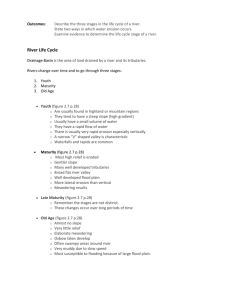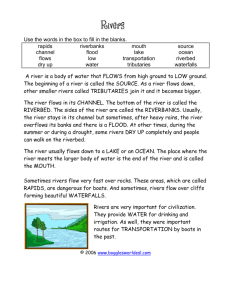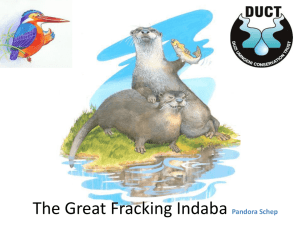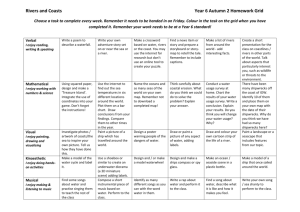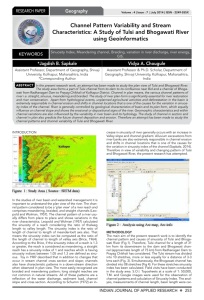28Feb06_lec
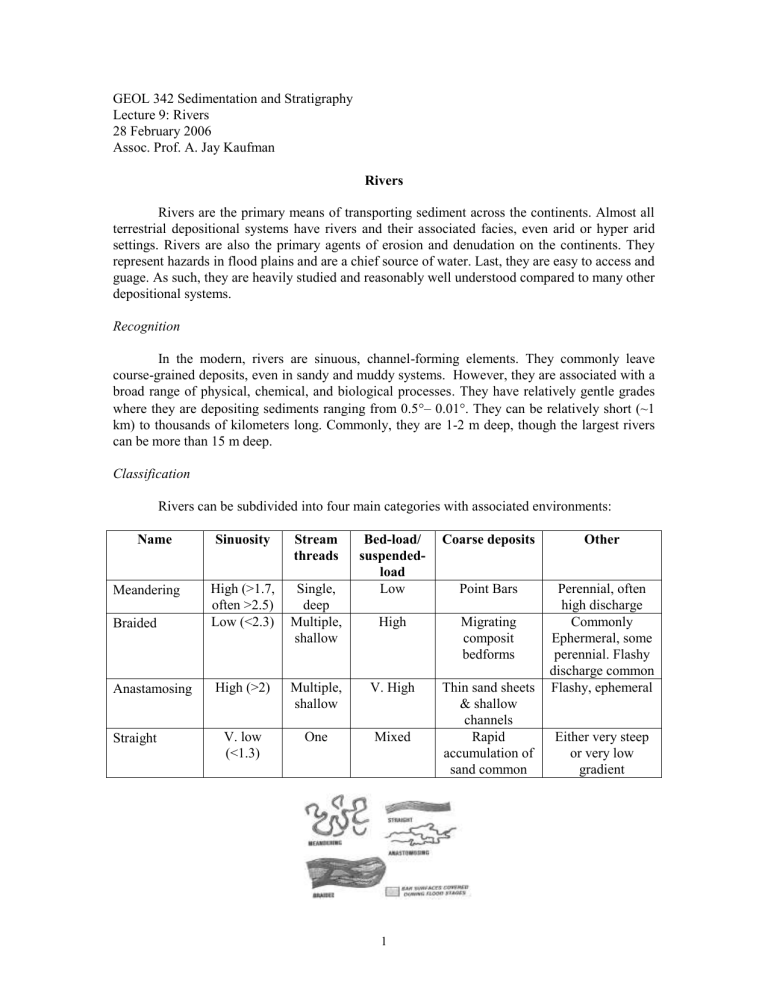
GEOL 342 Sedimentation and Stratigraphy
Lecture 9: Rivers
28 February 2006
Assoc. Prof. A. Jay Kaufman
Rivers
Rivers are the primary means of transporting sediment across the continents. Almost all terrestrial depositional systems have rivers and their associated facies, even arid or hyper arid settings. Rivers are also the primary agents of erosion and denudation on the continents. They represent hazards in flood plains and are a chief source of water. Last, they are easy to access and guage. As such, they are heavily studied and reasonably well understood compared to many other depositional systems.
Recognition
In the modern, rivers are sinuous, channel-forming elements. They commonly leave course-grained deposits, even in sandy and muddy systems. However, they are associated with a broad range of physical, chemical, and biological processes. They have relatively gentle grades where they are depositing sediments ranging from 0.5
– 0.01
. They can be relatively short (~1 km) to thousands of kilometers long. Commonly, they are 1-2 m deep, though the largest rivers can be more than 15 m deep.
Classification
Rivers can be subdivided into four main categories with associated environments:
Name
Meandering
Sinuosity Stream threads
High (>1.7, often >2.5)
Single, deep
Bed-load/ suspendedload
Low
Coarse deposits
Point Bars
Other
Perennial, often high discharge
Braided
Anastamosing
Low (<2.3) Multiple, shallow
High (>2) Multiple, shallow
High Migrating composit bedforms
Commonly
Ephermeral, some perennial. Flashy discharge common
Flashy, ephemeral
Straight V. low
(<1.3)
One
V. High Thin sand sheets
Mixed
& shallow channels
Rapid accumulation of sand common
Either very steep or very low gradient
1
The sinuosity of a river refers to the length of a line divided by the length of a straight line between it’s endpoints. In rivers, this is commonly done along the thalweg, the deepest part of a river channel. A bar is a composite, constructional bedform usually composed of sand or gravel.
Name
Oxbow lakes
River type
Meandering
Depositional Style
Fine-grained, lots of biota
Associated deposits
Laminated mudstones
Flood plains All types Fine-grained, some biota Paleosols
Crevasse
Splay
All, but commonly meandering
Course & fine grained, rapid accumulation
Climbing current ripples common, fine sand
Swamps All, but commonly meandering
Meandering rivers
Very high concentrations of vegetation
Coals, organic-rich mudstones
These are high sinuosity, single channel rivers characterized by relatively low slopes relative to discharge, relatively high discharge relative to load, and relatively low bed load relative to suspended load. A necessary condition for the formation of sinuous channels is highcohesive strength banks, commonly muddy and vegetated (Note: before the evolution of land plants there is no evidence of meandering river deposition). Most rivers in the modern world are meandering and are muddy systems, although they can leave sandy deposits. A critical aspect of these sytems is that the channel migrates through time, both laterally and down stream. It does this due to helical flow in sinuous bends which erode the outer banks.
Point bars
As a channel migrates, it often leaves a characteristic set of deposits behind called a point bar. The succession is coarsest at the base and fines upwards. It also shows decreasing flow energy, from trough cross-bedding and rip-up clasts at the base to climbing current ripples and silty suspension deposits. The cross strata are very large, commonly the depth of the whole channel. A point bar will grow laterally until the channel avulses or spontaneously changes course. Commonly, a late-stage channel fill is also preserved.
2
Oxbow lakes
These lakes are created during small avulsions in a meandering stream. A cuhute develops that shortens the length of the channel. This can occur either across the point bar or at the meander neck. If this chute becomes the dominant channel, it will abandon the older channel segment, forming a local crescent-shaped lake. These lakes will fill with fine-grained sediment deposited during floods and overbank flow. They are the site of thick and persistent vegetation.
Flood plain
When rivers flood, water flows out of the main channel and across the flood plain. The water will carry sediment, chiefly in suspension. As the flow decelerates, that material will accumulate in an overbank position. These sediments are then overbank deposits or flood plain deposits. Adjacent to the channel, the deposits may become a bit sandier and slightly elevated compared to the rest of the flood plain. These accumulations are called levees.
3
Crevasse splay
If a river avulses out of its channel and breaks its levees, the main flow of a river can be diverted out of the channel and into the adjacent flood plain. As it does, the flow will expand and slow, dropping its load. This will build a small delta-shaped body of anastamosed channels and associated deposts called a crevasse splay.
Swamp
Swamps are river networks where the ground water table is very high. As such, a lot of vegetation accumulates in one place. The density of biological activity can create anaerobic conditions, leading to the preservation of organic detritus. Before burial, these deposits are called peat. After burial they become coal. Swamps can also accumulate a significant volume of siltstone and shale, some of which can be organic rich.
Braided rivers
These are low sinuosity, multiple channel rivers characterized by relatively high slopes relative to discharge, relatively low discharge relative to load, and relatively high bed load to suspended load. The channels are broad and shallow, often about 1 m deep. As such, one finds much evidence for upper flow regime (planar beds) as well as trough cross-bedding. The channels are separated by bars which have variable degrees of stability and vegetation. Flow may be either flashy or perennial. Many braided stream deposits are very coarse grained, commonly sandy and often gravelly. Braided streams are more common near mountain fronts due to the steeper gradients and high bedload components.
Nodal migration
During bank-full events, many channels will be simultaneously active and moving sediment. The sediment will collect into very large composite bedforms (bars). Streams will diverge around bars and then reconverge on the downstream side. That convergent point or node
4
is a site for flow acceleration, causing double-helical flow and downstream erosion. That erosion will migrate downstream, inducing deposition just above the node.
Anastamosing rivers
These are high sinuosity, multiple channel rivers characterized by relatively high slopes relative to discharge and relatively high bed load to suspended load. The channels are broad and shallow, often about 1 m deep. These are rivers that are commonly depositing a large volume of sediment rapidly. This may be due to rapid deceleration of flow due to abrupt decreases in gradient, avulsion, evaporation, or loss of discharge into the ground. Due to these boundary conditions, anastamosed rivers are not very common.
Terminal splay
A typical setting for an anastamosing system is in a river that is rapidly losing flow into the substrate or due to evaporation (arid and semi-arid climates are typical). The flow depth decreases and velocity decreases, leading to deposition of broad sand sheets in or near thin, shallow channels. These channels will avulse rapidly and repeatedly over short time and length scales creating a complex distributary network. These are called inland deltas or terminal splays.
Straight Rivers
These commonly occur in two settings. One is in very steep reaches (mountains) or areas with small discharge. The other is in very low gradient distributary channels in coastal plain environments. These channels may also be a function of underlying structure (faulting or jointing of bedrock; i.e. Great Falls).
5
Depositional Style
A river channel or network of channels can create a broad, tabular sand body. These deposits are often referred to as a story. If these channels amalgamate, they will form a multi-story deposit. If discreet sand bodies are preserved without amalgamation, the deposit is considered single story.
6

